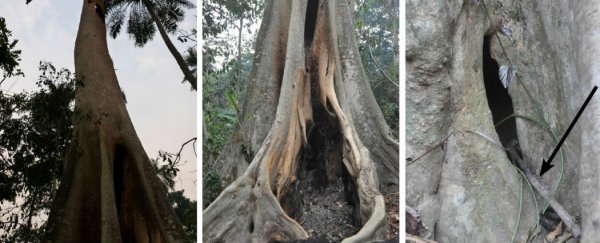The origin of the Ebola outbreak that has so far infected 20,000 people - 7,800 of which have died - has been traced to a single tree in the village of Méliandou in the African country of Guinea.
Earlier this year, scientists were able to identify 'patient zero' of the 2014 Ebola outbreak - a two-year-old boy named Emile Ouamouno from Méliandou, who suffered from Ebola-like symptoms before passing away. His mother, sister and grandmother died soon after, but no adult males died in this first appearance of the virus, according to David Quammen at National Geographic.
What does this mean? Researchers at the Robert Koch-Institute in Germany have suggested that the lack of adult males in the earliest stages of the outbreak means its origin didn't stem from hunting, as so many zoonotic, or cross-species, diseases - including previous outbreaks of Ebola - often have.
"But that left another question: If hunting or eating bat meat had caused the first infections, why hadn't an adult - who surely would have had more contact with the bats than a toddler who might nibble on them - get Ebola first?" says Rachel Feltman at The Washington Post. "It's possible to get the virus just from extended contact with an infected, living animal, but Meliandou isn't a forest - it's a fairly modern village."
Instead, they hypothesise that young children hunting and eating Angolan free-tailed bats (Mops condylurus), which are too small for the adult hunters to bother with, could have been the cause.
"These bats are reportedly targeted by children, who regularly hunt and grill them over small fires," the team writes in the current edition of EMBO Molecular Medicine.
Quammen paints a cosy picture, which explains why these little bats were so enticing to the local kids - "Imagine a marshmallow roast, except the marshmallows are mouse-size bats devoured by protein-hungry children," he writes.
Formulating this hypothesis was no easy task - it required intensive sleuthing at what they believe to be the source, Méliandou, interviewing locals and seeking out day-to-day activities that could hold vital clues. Populations of domestic animals kept by the locals were all tested, but came up clear, as did large wild animals such as monkeys, and chimpanzees. Eventually the researchers concluded that bats were the most likely carriers of the virus, and that's where the popular bat-tree came in.
While this species of bat is not known to roost in large congregations nearby Méliandou, this single hollow tree, called lolibelo by the locals, did house a single substantial family of them that Ouamouno unquestionably came into contact with while playing with his peers.
It's probably the best hypothesis we have so far, but the mystery is far from settled - we might have evidence that fruit bats carry and spread Ebola, we have precious little of the same for Angolan free-tailed bats.
Quammen explains at National Geographic:
"Bats of that species have previously been found to contain antibodies against Ebola virus, but the sample numbers were very small, and antibodies are weak evidence. The species has therefore not been included among the prime suspects as a reservoir for Ebola. That could change, if further sampling of Angolan free-tailed bats reveals any stronger data connecting the bat and the virus."
Further research will hopefully cement or discount this hypothesis, but if proven, it presents a pretty sobering picture of what the future could hold. These little, mouse-sized bats don't particularly like living so close to humans, but continued forest clearing for houses and farming are forcing them to share the locals' homes, holing up in ceiling rafters and in the walls. And the closer they get to where the locals are eating and sleeping, the more likely the spread of Ebola - if, and it's a big if, this species does in fact carry it.
Sources: National Geographic, The Washington Post
